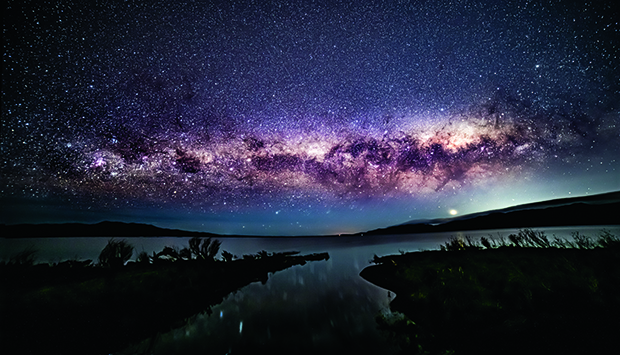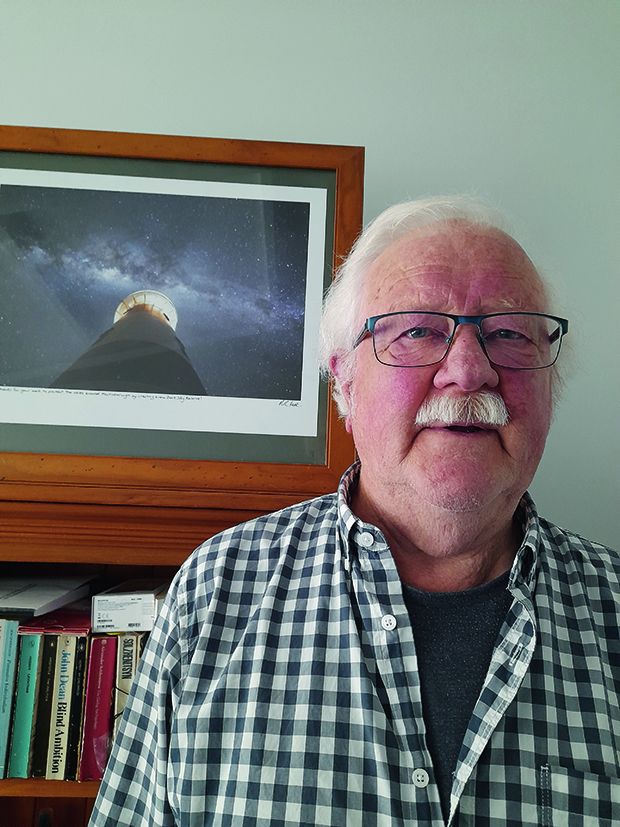Starry, starry night: The man helping to bring the night sky to life in the Wairarapa

A billion stars over Lake Wairarapa.
Keeping the Wairarapa in the dark is a six-year mission for a resident and his band of like-minded enthusiasts.
Words: Marisa King
Six years ago, on a clear Wairarapa night, retired journalist Ray Lilley gazed up at the stars and had an idea.
At the time, Ray was growing olives in Martinborough, though he had spent 15 years reporting on New Zealand events for the global news organisation, Associated Press.
One issue he wrote about that intrigued him during his journalism days was the campaign to create New Zealand’s first Dark Sky Reserve, Aoraki-Mackenzie. The campaign’s success, in 2012, saw the creation of a 4367-square-kilometre reserve, including Aoraki/Mount Cook and Lake Tekapo.
As he stood on his back lawn, looking up, he thought, “That’s the same sky as Tekapo.” He contacted well-known local businessman David Kershaw, and the pair organised and publicised a public meeting.
Approximately 45 people turned up to hear about a Dark Sky Reserve in the Wairarapa, formed a committee and got to work. Years of form-filling, application writing, public-light measuring and good old-fashioned determination were to follow.
In January this year, the Carterton and South Wairarapa districts (including Featherston, Greytown and Martinborough) were formally certified as New Zealand’s second Dark Sky Reserve by the International Dark-Sky Association (IDA) — one of only 21 sites worldwide deemed by international astronomy experts to have the best views of the night skies.

Ray Lilley.
A Dark Sky Reserve consists of a dark core zone — Aorangi Forest Park, in Wairarapa’s case — and a peripheral area where light pollution is controlled to protect the core.
As part of their application, Ray and his fellow volunteers had to prove that all regional public lights (such as those at shopping centres, schools and railway stations) met stringent IDA standards of reduced light pollution.
“Many a cold winter night was spent outside logging and measuring every goddamned public light in the region,” says Ray.
A lucky break came in a preliminary meeting with South Wairarapa’s mayor, during which Ray learned that Waka Kotahi was about to install new street lighting across the Wairarapa that would not meet dark-sky standards.
“We got hold of a very good lighting engineer who got into discussions with them,” says Ray. “He was able to prove that dark-sky-compliant lighting would be just as effective and wouldn’t cost any extra.”
Eventually, Waka Kotahi agreed to install dark-sky lighting across the region, greatly boosting the IDA application. Even so, Ray and his team submitted six drafts of a 200-page application before receiving the Dark Sky certification. “They [the IDA] did admit later they had been overly bureaucratic,” says Ray.
The Wairarapa is now starting to leverage its new status with several tourism operators offering stargazing experiences and tours.
Unsurprisingly, Ray is rather pleased with the outcome of his lightbulb moment six years ago.
“I was driving along State Highway 2 [through the Wairarapa] at night recently, and it looked so bloody good,” he says.
“There used to be big globes of light beaming in all directions.”
SHEDDING LIGHT ON THE DARK-SKY MOVEMENT
The International Dark-Sky Places programme was formed in 2001 in response to the effect of excessive artificial light on people and the environment.
The International Dark-Sky Association certifies communities, parks and other places that preserve and protect dark sites with effective policies to reduce light pollution and promote public education, with more than 200 certified Dark Sky sites in 22 countries.
Five categories of Dark Sky certification are available, including Dark-Sky Sanctuaries, which comprise the world’s most remote (and often darkest) places. New Zealand has two sanctuaries — Aotea/Great Barrier Island and Rakiura/Stewart Island.
Our country’s interest in dark-sky protection is growing, with Kaikōura, Kūaotuna (Coromandel), Oxford, Naseby and Fiordland all pursuing accreditation. There has even been talk of New Zealand becoming a dark-sky nation.
Love this story? Subscribe now!
 This article first appeared in NZ Life & Leisure Magazine.
This article first appeared in NZ Life & Leisure Magazine.
